Glass bottles: syrup rounds

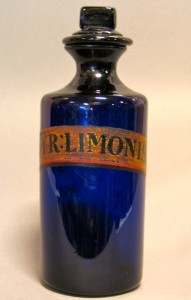 The syrup bottles in Bradford on Avon Museum’s pharmacy are of mouth-blown blue (cobalt) glass with flared necks to give easy pouring and loose-fitting stoppers that can be opened even if the syrup has stuck them to the opening. Each has a label with the contents in abbreviated Latin. Most of these mixtures were to be used in treating coughs or were ingredients of purgatives.
The syrup bottles in Bradford on Avon Museum’s pharmacy are of mouth-blown blue (cobalt) glass with flared necks to give easy pouring and loose-fitting stoppers that can be opened even if the syrup has stuck them to the opening. Each has a label with the contents in abbreviated Latin. Most of these mixtures were to be used in treating coughs or were ingredients of purgatives.
SYR:LIMONIS (left) is simply syrup of lemon. It has astringent qualities that would have been used to help soothe sore throats. Many modern proprietary medicines and throat sweets still include lemon among their ingredients.
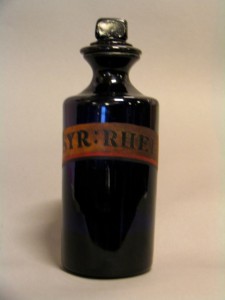 SYR:RHEI (right) is syrup made with the roots of the familiar garden plant rhubarb, Rheum rabarbarum. It was known for centuries, beginning in Asia, that the powdered roots could be used as a laxative; they are rich in substances known as anthraquinones, such as emodin and rhein, which have cathartic and laxative properties.
SYR:RHEI (right) is syrup made with the roots of the familiar garden plant rhubarb, Rheum rabarbarum. It was known for centuries, beginning in Asia, that the powdered roots could be used as a laxative; they are rich in substances known as anthraquinones, such as emodin and rhein, which have cathartic and laxative properties.
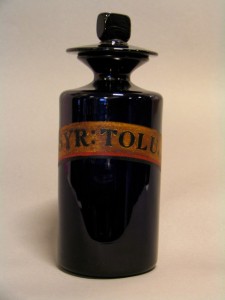 SYR:TOLU is a syrup containing the resinous secretion of the South American tree Myroxylon balsamum. It gets its name from a pre-Columbian people who collected the resin by making incisions in the bark of the tree and are recalled by the town of Tolú in northern Colombia.
SYR:TOLU is a syrup containing the resinous secretion of the South American tree Myroxylon balsamum. It gets its name from a pre-Columbian people who collected the resin by making incisions in the bark of the tree and are recalled by the town of Tolú in northern Colombia.
Tolu is used as an expectorant in cough medicines and for treating skin rashes. It is also used in perfumery and as a flavouring. It is one of the main active ingredients of Saunders’ Balsamic Syrup, the cough medicine that was made at the shop in Bradford Museum during its 123 year history.
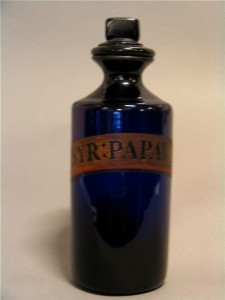 SYR:PAPAV:A: (right) is syropus papaveris albi, a syrup that is made with the fresh petals of the white or opium poppy, Papaver somniferum. Although this plant gives us some very powerful drugs, such as morphine and heroin, this is a very mild preparation that would have been used in making expectorants for treating coughs.
SYR:PAPAV:A: (right) is syropus papaveris albi, a syrup that is made with the fresh petals of the white or opium poppy, Papaver somniferum. Although this plant gives us some very powerful drugs, such as morphine and heroin, this is a very mild preparation that would have been used in making expectorants for treating coughs.
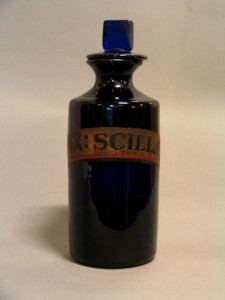 OX:SCILLAE (left) is an oxymel of squill, a medicine that is said to have been invented by the ancient Greek mathematician Pythagoras in the 6th century BC. It is made from a vinegar extract of the sea squill, Urginea maritima -the big bulbs that are found in dry places around the Mediterranean, mixed with honey. Squill stimulates the bronchial mucous membrane, so is a useful expectorant and treatment of bronchitis, although it has other properties as well.
OX:SCILLAE (left) is an oxymel of squill, a medicine that is said to have been invented by the ancient Greek mathematician Pythagoras in the 6th century BC. It is made from a vinegar extract of the sea squill, Urginea maritima -the big bulbs that are found in dry places around the Mediterranean, mixed with honey. Squill stimulates the bronchial mucous membrane, so is a useful expectorant and treatment of bronchitis, although it has other properties as well.
The Museum also has a bottle of Syrup of Squill.
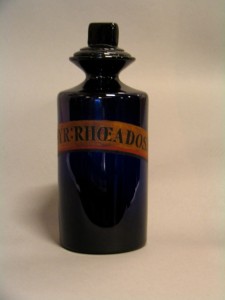 SYR:RHOEADOS (right) is a syrup made with the petals of the common red field poppy, Papaver rhoeas. The petal have to be used as fresh as possible, because they fade very quickly. The syrup is deep red and may have been used just as a colourant, although the poppy may be faintly narcotic.
SYR:RHOEADOS (right) is a syrup made with the petals of the common red field poppy, Papaver rhoeas. The petal have to be used as fresh as possible, because they fade very quickly. The syrup is deep red and may have been used just as a colourant, although the poppy may be faintly narcotic.
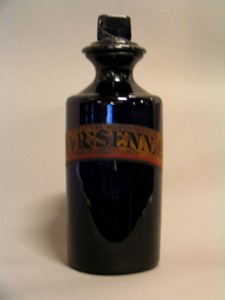 SYR:SENNAE (left) is syrup made of senna, a material famous for its laxative properties. Senna comes from the leaves and seed pods of Cassia acutifolia, a plant that belongs to the legume family. It was traditionally grown in Nubia, in Upper Egypt and Sudan. The active chemicals, which are similar to those in aloes and rhubarb, affect the lower bowel.
SYR:SENNAE (left) is syrup made of senna, a material famous for its laxative properties. Senna comes from the leaves and seed pods of Cassia acutifolia, a plant that belongs to the legume family. It was traditionally grown in Nubia, in Upper Egypt and Sudan. The active chemicals, which are similar to those in aloes and rhubarb, affect the lower bowel.
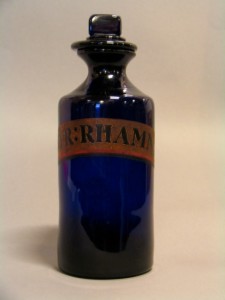 SYR:RHAMNI (right) is another purgative, made from the bitter juice of the ripe berries of the purging or common buckthorn, Rhamnus cathartica, a common shrub that grows wild in Wiltshire. The bitter taste is disguised by the sugar syrup and often by adding ginger, aniseed and cinnamon. It is said that even the meat of birds that have eaten buckthorn berries is purgative too.
SYR:RHAMNI (right) is another purgative, made from the bitter juice of the ripe berries of the purging or common buckthorn, Rhamnus cathartica, a common shrub that grows wild in Wiltshire. The bitter taste is disguised by the sugar syrup and often by adding ginger, aniseed and cinnamon. It is said that even the meat of birds that have eaten buckthorn berries is purgative too.

